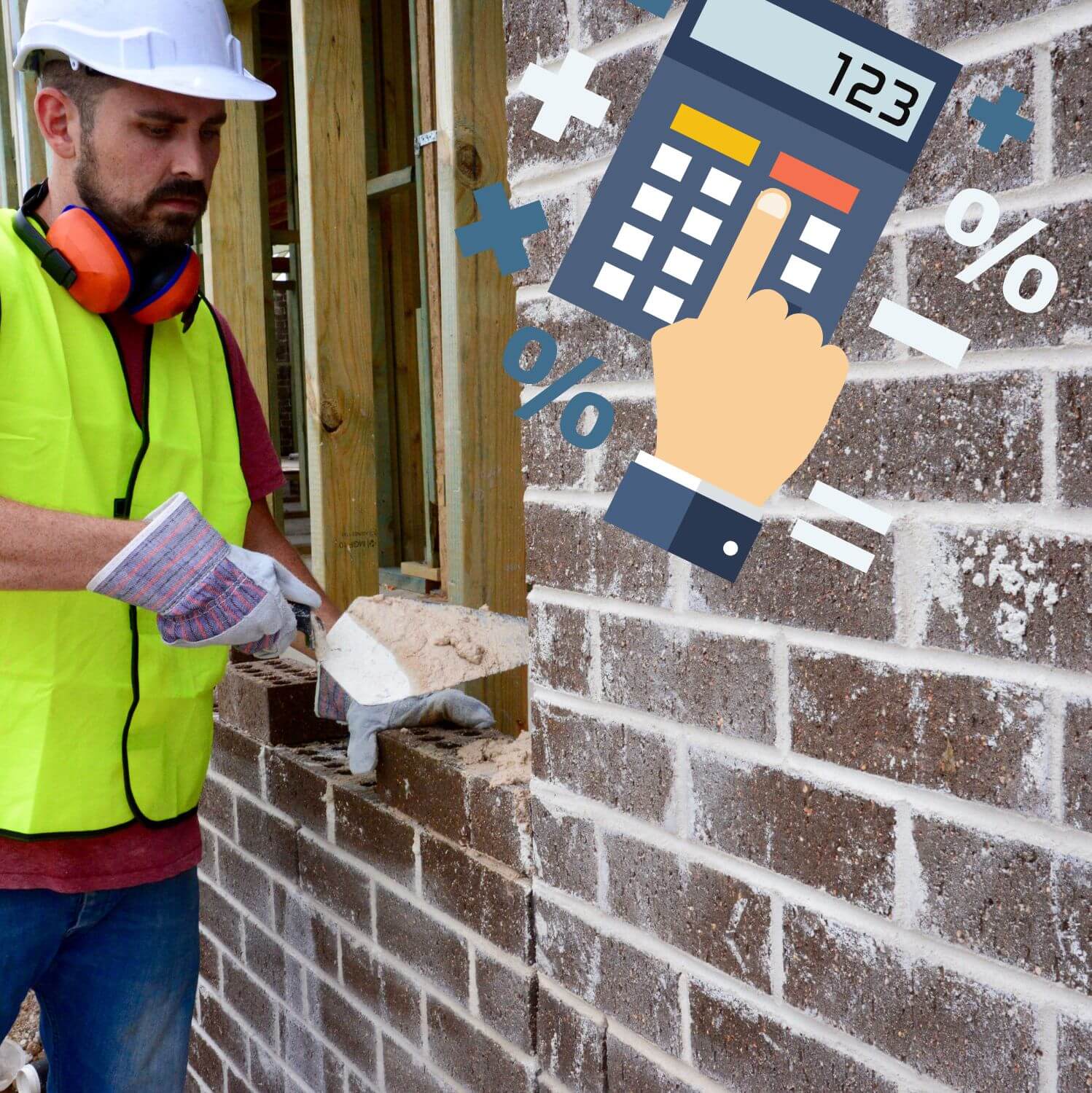
Have you ever found yourself in the midst of a home improvement project, scratching your head and wondering how many bricks you actually need? Well, worry no more! We have the solution for you – the Brick Calculator Tool.
This amazing tool will save you time, money, and headaches by precisely calculating the number of bricks required for your project. Whether you’re building a patio, a wall, or a whole house, this user-friendly tool will be your trusty companion from start to finish. Say goodbye to guesswork and hello to accurate calculations with the Brick Calculator Tool.

Choosing the Right Brick Calculator Tool
Understanding the Purpose of a Brick Calculator
A brick calculator tool is a valuable resource for anyone involved in a bricklaying project. It is designed to help calculate the quantity of bricks and mortar needed for a construction job.
By inputting specific parameters such as brick size, wall dimensions, and mortar type, the tool provides accurate estimations, saving time, effort, and material. Whether you are a professional bricklayer or a DIY enthusiast, using a brick calculator tool can greatly enhance the accuracy and efficiency of your project planning.
Considering the Types of Projects
Before selecting a brick calculator tool, it’s important to consider the types of projects you will be undertaking. Different tools may be designed for specific project types, such as exterior or interior walls, or may have additional features for more complex projects. By assessing the specific requirements of your projects, you can choose a calculator tool that best suits your needs.
Evaluating the Features and Functions
When comparing different brick calculator tools, it’s essential to evaluate the features and functions offered by each tool. Look for tools that provide options for adjusting parameters such as brick size, mortar joint thickness, and wall dimensions. Some tools may also offer advanced options for calculating brick ties or metal reinforcement, mortar additives or dyes, as well as estimating cost and time. By reviewing the features of each tool, you can determine which one provides the necessary functionality for your projects.
Comparing Different Brick Calculator Tools
To ensure you choose the right brick calculator tool, it’s important to compare different options available in the market. Consider factors such as user-friendliness, reliability, and accuracy. Look for tools that have positive user reviews and ratings, as this can be a testament to their effectiveness. Additionally, consider whether the tool is compatible with your device or operating system. By comparing multiple tools, you can make an informed decision and select the one that best meets your requirements.
Getting Started with a Brick Calculator Tool
Finding a Reliable Brick Calculator Tool
Finding a reliable brick calculator tool is the first step in getting started. Conduct thorough research to identify reputable brick calculator tools available online or through software applications. Look for tools that have been developed by trusted sources with a track record of accuracy and reliability. Additionally, consider tools that have positive user feedback and ratings to ensure their effectiveness.
Accessing the Tool
Once you have identified a reliable brick calculator tool, the next step is to access it. Depending on the source of the tool, you may need to download it from a website or install it as a software application on your device. Ensure that you follow the instructions provided by the developer to ensure a seamless installation process. Once the tool is installed, you can proceed to open it and begin utilizing its features.
Understanding the User Interface
Upon accessing the brick calculator tool, take some time to familiarize yourself with its user interface. The user interface is the visual representation of the tool and includes various buttons, input fields, and settings. Pay attention to the layout and organization of the interface, as it will determine how easily you can navigate and input the necessary parameters for your calculations. Familiarizing yourself with the user interface will allow you to efficiently use the tool and make the most of its functionalities.
Entering the Relevant Parameters
After getting acquainted with the user interface, you can start entering the relevant parameters into the brick calculator tool.
Begin by choosing the appropriate brick size from the options provided. The brick size selection should align with the bricks you intend to use for your project. Next, determine the brick bond required for your project, such as stretcher bond, English bond, or Flemish bond.
Enter the dimensions of the wall, including height, length, and width, into the corresponding input fields. Lastly, consider any openings in the wall, such as windows or doors, and factor in an adequate wastage percentage. By accurately inputting these parameters, the brick calculator tool will generate precise estimations for the quantity of bricks and mortar required.
Calculating the Quantity of Bricks
Choosing the Brick Size
One of the critical factors in accurately calculating the quantity of bricks is selecting the correct brick size. Different brick sizes are available in the market, ranging from standard sizes to custom dimensions. The chosen brick size should match the requirements of your project, both aesthetically and structurally. Taking into consideration the desired appearance, load-bearing capacity, and available space, select the most suitable brick size from the options offered by the brick calculator tool.
Determining the Brick Bond
The brick bond refers to the pattern in which the bricks are laid, affecting both the structural integrity and aesthetic appeal of the wall. Common brick bond patterns include stretcher bond, English bond, Flemish bond, and more.
The chosen bond pattern should align with the design and purpose of the project. Consult architectural plans or seek professional advice to determine the appropriate brick bond for your project. Once you have decided on the brick bond, input this information into the brick calculator tool to ensure accurate calculations.
Entering the Wall Dimensions
Accurate measurements of the wall dimensions are essential for precise brick quantity calculations. Using a tape measure or laser level, determine the height, length, and width of the wall. Ensure you measure all sides and corners to eliminate any discrepancies. Record these measurements and input them carefully into the brick calculator tool. The tool will utilize these dimensions to provide an estimation of the number of bricks required for your project.
Adjusting for Openings and Wastage
It is important to account for any openings in the wall, such as windows or doors, when calculating the quantity of bricks. These areas will require special arrangements and may reduce the number of full-sized bricks needed.
Additionally, when estimating the quantity of bricks required, it is advisable to factor in a wastage percentage. Wastage can occur due to cuts, breakage, or unforeseen circumstances during construction. By adjusting for openings and wastage in the brick calculator tool, you can ensure a more accurate calculation of the required number of bricks.
Estimating Mortar Required
Understanding the Importance of Mortar Estimation
Mortar is an essential component in bricklaying, providing structural stability and durability to the wall. Estimating the quantity of mortar required is crucial to ensure sufficient coverage and adherence between the bricks. Insufficient mortar can compromise the integrity of the wall, while excess mortar may result in wastage and unnecessary costs. Using the brick calculator tool, accurate estimation of mortar quantities can be achieved by inputting the appropriate parameters.
Selecting the Mortar Type and Mix Ratio
The choice of mortar type and mix ratio is determined by the specific requirements of the project. Mortar types may include cement-lime mortar, cement-sand mortar, or other variations. The mix ratio corresponds to the proportions of cement, lime, and sand used in the mortar composition. Consider consulting with a professional or referring to architectural plans to determine the most suitable mortar type and mix ratio for your project. Once selected, input these parameters into the brick calculator tool for precise mortar estimation.
Entering Mortar Joint Thickness
The mortar joint thickness refers to the width of the mortar between the bricks. It plays a significant role in the aesthetics and structural integrity of the wall. The joint thickness can vary depending on factors such as brick type, bond pattern, and design preferences. Consult architectural plans or seek professional advice to determine the appropriate mortar joint thickness for your project. Input this value into the brick calculator tool to obtain accurate estimations of the mortar quantity required.
Calculating Mortar Quantity
Once the mortar type, mix ratio, and joint thickness have been determined, the brick calculator tool can calculate the quantity of mortar required. By analyzing the brick and wall dimensions, as well as the mortar parameters, the tool will generate precise estimations for the amount of mortar needed. This information is invaluable for efficient project planning, allowing you to accurately order the required quantity of mortar.

Accounting for Peripheral Factors
Considering the Exterior or Interior Wall
Whether you are constructing an exterior or interior wall, it is important to consider the specific requirements associated with each. Exterior walls are subjected to various environmental factors, such as temperature changes and moisture, requiring additional considerations for insulation, weatherproofing, and drainage. Interior walls, on the other hand, may focus more on aesthetics and acoustic properties. Ensure that your brick calculator tool can adapt to the specific requirements of the wall type you are working on.
Factoring in Window and Door Openings
When calculating the quantity of bricks and mortar required, it is crucial to account for window and door openings in the wall. These areas require special arrangements, such as lintels or arches, and may result in the use of fewer full-sized bricks. By factoring in these openings in the brick calculator tool, you can ensure accurate estimations and avoid unnecessary material wastage.
Determining the Height of the Wall
The height of the wall is a significant factor in brick quantity calculations. Taller walls require more bricks and mortar to maintain stability and structural integrity. When measuring the wall height, consider any height variations or steps in the wall design. Consulting architectural plans or seeking professional advice will assist in accurately determining the height of the wall and inputting this information into the brick calculator tool.
Adjusting for Slopes or Staircases
In some cases, bricklaying projects may involve walls with slopes or staircases. These architectural features require additional considerations to ensure proper alignment, stability, and aesthetic appeal. The inclusion of slopes or staircases may affect the calculation of brick and mortar quantities. Consult architectural plans or seek professional advice to accurately determine the adjustments required for slopes or staircases in your project.
Reviewing and Refining the Results
Double-checking the Entered Values
Upon receiving the estimation results from the brick calculator tool, it is crucial to double-check the entered values. Review the input parameters for brick size, brick bond, wall dimensions, mortar type and mix ratio, joint thickness, openings, and wastage to verify their accuracy. Identifying any errors or discrepancies at this stage will ensure that the final calculations are precise and reliable.
Verifying the Calculation Accuracy
Once you have double-checked the entered values, it is essential to verify the calculation accuracy of the brick calculator tool. Compare the tool’s estimations with other reliable sources, such as industry standards or architectural guidelines. By cross-referencing the calculations, you can ensure that the tool has generated accurate results, giving you confidence in the quantities determined.
Making Adjustments if Required
If you identify any discrepancies or variations in the estimations provided by the brick calculator tool, it may be necessary to make adjustments. Review the parameters and consider altering factors such as brick bond, joint thickness, or wastage percentage. However, it is crucial to consult with a professional or refer to architectural plans before making any significant changes. By fine-tuning the parameters, you can achieve more accurate results and ensure your project’s success.
Saving or Printing the Results
After reviewing and refining the estimations provided by the brick calculator tool, it is advisable to save or print the results for future reference. Storing the calculations will allow you to easily access and compare them during different stages of the project. By having a record of the estimations, you can avoid repetitive calculations and ensure consistency in material ordering and project planning.

Using Additional Features
Exploring Advanced Options
Some brick calculator tools offer advanced options that can enhance the accuracy and efficiency of your project planning. Consider exploring these features to gain additional insights into more complex projects or construction requirements.
Advanced options may include calculations for brick ties or metal reinforcement, considering mortar additives or dyes, as well as estimating the cost and time associated with the project. Assess the suitability of these advanced options for your specific needs and utilize them to optimize your bricklaying project.
Calculating Brick Ties or Metal Reinforcement
In certain construction projects, the use of brick ties or metal reinforcement may be necessary to enhance the structural integrity of the wall.
These reinforcements provide additional strength and stability to the brickwork. If your project requires brick ties or metal reinforcement, ensure that the brick calculator tool offers the functionality to calculate the quantities and specifications of these components. Factor in the calculations of brick ties or metal reinforcement into your overall estimations for a comprehensive understanding of materials required.
Considering Mortar Additive or Dyes
If you plan to incorporate mortar additives or dyes into your bricklaying project, it is important to factor in their quantities during estimation. Mortar additives can provide various benefits such as increased flexibility, improved water resistance, or enhanced adhesive properties.
Similarly, mortar dyes can be used to achieve specific color effects, creating visually appealing brickwork. When selecting a brick calculator tool, make sure it allows for the calculation of mortar additives or dyes, if applicable to your project.
Estimating Cost and Time
In addition to materials estimation, some brick calculator tools offer the ability to estimate the cost and time associated with the project. By inputting parameters such as material prices and labor rates, the tool can provide a rough estimation of the project’s financial and time requirements. This information can be valuable for budgeting purposes and overall project planning, allowing you to assess feasibility and make informed decisions.
Troubleshooting and FAQs
Common Issues and Solutions
During the brick calculation process, it is possible to encounter common issues or challenges. Some problems may arise due to incorrect input of parameters, such as inaccurate wall dimensions or brick bond selection. Other issues may stem from software or compatibility problems with the calculator tool. To resolve these issues, refer to the tool’s user guide, FAQ section, or seek assistance from customer support. Additionally, reviewing tutorials, guides, or joining online forums can provide insights into common problems and potential solutions.
Handling Measurement Units
Measurement units play a crucial role in accurately calculating the quantity of bricks and mortar required. Ensure that you are using consistent units throughout the calculation process, such as inches, feet, or meters. Pay attention to conversions if necessary and verify that the brick calculator tool is set to the appropriate units. Following standardized measurement units will ensure precise estimations and prevent errors in material ordering.
Dealing with Different Brick Shapes
When working with different brick shapes, the estimation process may require additional adjustments. Non-standard brick shapes, such as corner bricks or arch bricks, may have specialized dimensions that need to be considered. Consult architectural plans, seek professional advice, or refer to the manufacturer’s specifications to accurately determine the dimensions and quantities of these specialized brick shapes. Inputting the correct parameters into the brick calculator tool will result in more accurate estimations tailored to your unique brick shapes.
Frequently Asked Questions
Q: Is a brick calculator tool suitable for both DIY projects and professional bricklaying? A: Yes, a brick calculator tool can be utilized by both DIY enthusiasts and professional bricklayers. It provides accurate estimations for brick and mortar quantities, regardless of the scale or complexity of the project.
Q: Can a brick calculator tool be used for different bond patterns? A: Yes, brick calculator tools typically offer options for various bond patterns, such as stretcher bond, English bond, or Flemish bond. Select the appropriate bond pattern in the tool to ensure accurate calculations.
Q: How do I account for irregular shapes or angles in the wall? A: When encountering irregular shapes or angles in the wall, it is advisable to break down the wall into manageable sections and calculate the quantities separately. Input the dimensions of each section into the brick calculator tool to obtain accurate estimations for each part.
Q: Can a brick calculator tool estimate the number of bricks needed for a curved wall? A: Some brick calculator tools may have the functionality to estimate the number of bricks required for a curved wall. Consult the tool’s user guide or seek assistance from customer support to determine if this feature is available.
Widening the Scope with Online Resources
Discovering Additional Brick Calculators
While a brick calculator tool is an excellent resource for accurately estimating brick and mortar quantities, it is beneficial to explore additional options available online.
Conduct a search to discover other brick calculator tools developed by reputable sources. Consider user reviews, ratings, and functionality to ensure the tools meet your specific requirements. The availability of various brick calculator options will allow you to select the one that best suits your needs and preferences.
Exploring Tutorials and Guides
To maximize your understanding and utilization of brick calculator tools, explore tutorials and guides available online.
Many websites, software developers, and DIY communities provide resources that explain the features and functionalities of brick calculator tools. These resources can offer step-by-step instructions, tips, and tricks, as well as real-life examples to enhance your learning experience. By investing time in exploring tutorials and guides, you can enrich your knowledge and improve your ability to effectively use these tools.
Joining Online Forums or Communities
Joining online forums or communities dedicated to bricklaying and construction can provide valuable insights and advice from experienced professionals and enthusiasts. Engaging in discussions, asking questions, and sharing your experiences can broaden your understanding of brick calculator tools and their implementation.
Online communities often offer a platform to learn from others’ experiences, exchange ideas, and gain inspiration for your own projects. By actively participating in these communities, you can benefit from the collective wisdom of like-minded individuals.
Seeking Professional Advice
While brick calculator tools are effective in providing accurate estimations, seeking professional advice can further optimize your project planning. Consulting with experienced bricklayers, architects, or contractors can offer valuable insights and recommendations specific to your project. Professionals can provide guidance on factors beyond the scope of a brick calculator tool, such as specialized brick shapes, complex bond patterns, or unusual construction requirements. By seeking professional advice, you can ensure comprehensive planning and successful execution of your bricklaying projects.
Conclusion
Using a brick calculator tool is a smart choice for anyone involved in bricklaying projects, whether you are a DIY enthusiast or a professional bricklayer. By understanding the purpose, evaluating features, and comparing different options, you can select the right tool to meet your specific needs.
Once you have chosen a reliable brick calculator tool, familiarize yourself with its user interface and accurately input the relevant parameters. Utilizing the tool’s calculations, you can determine the quantity of bricks and mortar required, estimate additional factors, review and refine the results, and utilize advanced features.
While brick calculator tools greatly enhance the accuracy and efficiency of project planning, it is essential to review the calculations, troubleshoot if necessary, and seek professional advice when needed. By utilizing online resources, exploring additional tools, tutorials, and guides, joining online communities, and seeking professional advice, you can enhance your knowledge and excel in bricklaying projects.
The benefits of using a brick calculator tool are numerous, including improved accuracy and efficiency, time and material savings, and overall project planning improvements. By incorporating a brick calculator tool into your workflow, you can enhance the success of your bricklaying projects and achieve the desired results.






